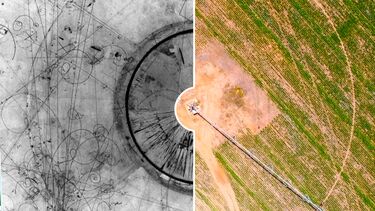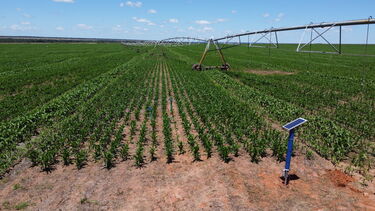From the stars to the soil: Can cosmic signals help farmers?
Soil moisture is vital for crop growth in arid regions, but traditional checks are slow. That’s why Sheffield physicists are turning to the stars for a solution, using cosmic rays to measure soil moisture data from afar. This data is powering irrigation systems that optimises water use for farmers.

In drought areas, crops rely heavily on the artificial application of water to land, also known as irrigation. To maximise yields, farmers typically use automatic irrigation systems with a continuous water stream to nourish crops. The agricultural sector consumes approximately 70 percent of the world’s freshwater, and more than 50 per cent can be wasted.
To grow healthy crops, farmers need to know exactly how much water to use. Too much or too little can be a problem. To help them figure out the perfect amount, they need to check how wet the soil is. One way they do this is by using special sensors called capacitance probes that measure how electricity moves through the soil. Because water changes how electricity flows, the sensors can tell how much water is in the ground. But these sensors can be tricky to set up and take care of - and if they have to keep taking them out to check them, they can break easily.
More importantly, capacitive probes used in soil moisture monitors can only measure the moisture content of the soil at the exact spots where they are placed, meaning they can miss variations in soil moisture that occur over wider areas in large fields. This limitation can result in an inaccurate assessment of the overall level of water stress in crops.
Researchers at the University of Sheffield are developing novel methods to monitor the moisture content over much larger areas of farmland. Dr Patrick Stowell, supported by an international team of researchers in Germany and Brazil, is working on alternative ground-breaking methods of monitoring soil moisture to make water use in agriculture more sustainable.
Cosmic helpers
Tiny particles, called cosmic rays, constantly come crashing into Earth from space. When they hit the air high above us, they break apart and create a shower of even smaller pieces. These showers are composed, in part, of neutrons, which are some of the primary building blocks of the world around us.
These cosmic ray neutrons usually zip right through things without doing much, except when they bump into hydrogen. As they travel down into the ground, they bounce off rocks and soil. But when they hit water, which contains hydrogen, they slow down and are captured. So, by measuring the number of neutrons in the soil, we can figure out how much water is there.
Dr Patrick Stowell from the School of Mathematical and Physical Sciences is developing next-generation sensors to detect neutrons above fields. The wetter the soil, the fewer particles are captured by these sensors, indirectly showing variations in soil moisture.
We simply place a sensor and leave it in the field, then it can continuously monitor how the neutron rate varies over time, and estimate how much the soil moisture is fluctuating.Dr Patrick Stowell
Lecturer in Particle Physics at the University of Sheffield
Cosmic-Ray Neutron Soil Sensors (CRNS) can detect changes in soil moisture up to 200 metres away from a single sensor down to a depth of 15-50 cm. Designed for easy 'plug-and-play' use, these sensors can be installed without disrupting the field, and their low-maintenance design offers a significant advantage. By deploying a few sensors to different spots in the field, farmers can also build maps of soil moisture from the data. Importantly, the unstoppable rain of cosmic radiation provides the sensor with real-time updates of water content.
Neutron detection can be challenging in the first place. Existing approaches were developed primarily for the nuclear sector, where scientists use gaseous sensors to see neutrons, including helium-3 and boron trifluoride sensors. However, the high cost of the former and toxic nature of the latter make them unsuitable for widespread agricultural use.
Working as a research fellow for the Royal Commission of the Exhibition of 1851, Stowell has spent the past few years considering alternative neutron sensor approaches that employ detectors made of boron nitride compounds. Neutrons interacting with these novel materials produce charged particles that can trigger flashes of light that make it possible to identify and count them.
“We can make these mixtures much cheaper compared to gaseous detectors, and they are also more stable because they are solid-state systems. They’re robust, less expensive to develop, and easier to deploy in the field” explains Dr Stowell.
Sustainability and AI in the industry
Funded by a Natural Environmental Research Council International Partnership grant, Dr Stowell and a team of researchers from UK, Brazil and Germany team are now working on linking new lower cost neutron sensors with an AI-powered irrigation system, named the Smart Water Management Platform (COSMIC-SWAMP), to support variable rate irrigation in arid regions.
Integrated with automated data processing tools, the platform can aggregate neutron based soil moisture data and weather information to create irrigation prescriptions, forecast yield and analyse crop growth conditions.
“There are lots of different environmental effects and what we can do is provide them with real-time monitoring data that can be used to directly inform how they should make changes to their irrigation" adds Dr Stowell.
In arid and tropical regions, this CRNS supporting platform is focused on enabling variable rate irrigation on large sites, contributing to climate-resilient agriculture. Having finished trials at pilot fields in Brazil, Dr Stowell’s international team is developing the sensor platform as a general-purpose tool for irrigation optimization. To enhance the design of detectors, they are looking at scheduling future tests on larger sites in South America - in partnership with Embrapa, the Brazilian agricultural research council.
The research team has previously collaborated with the UK Centre for Ecology and Hydrology on the technical requirements and design of new CRNS through funding from the Science and Technology Facilities Council (STFC) Food Network, an association that brings researchers together and applies science, technology, engineering and mathematics knowledge to tackle global food issues.
For further information contact: mediateam@sheffield.ac.uk.

